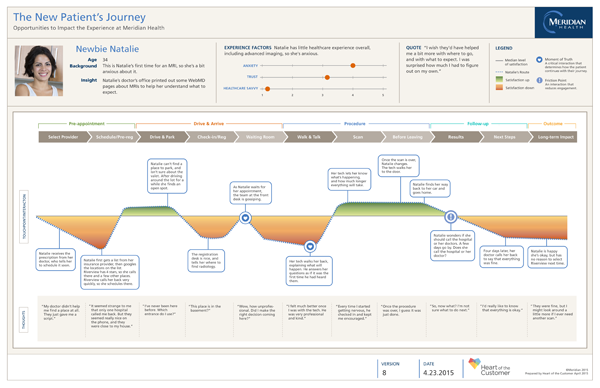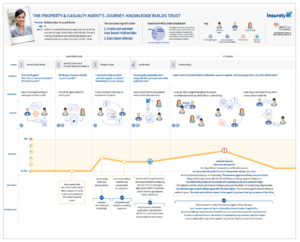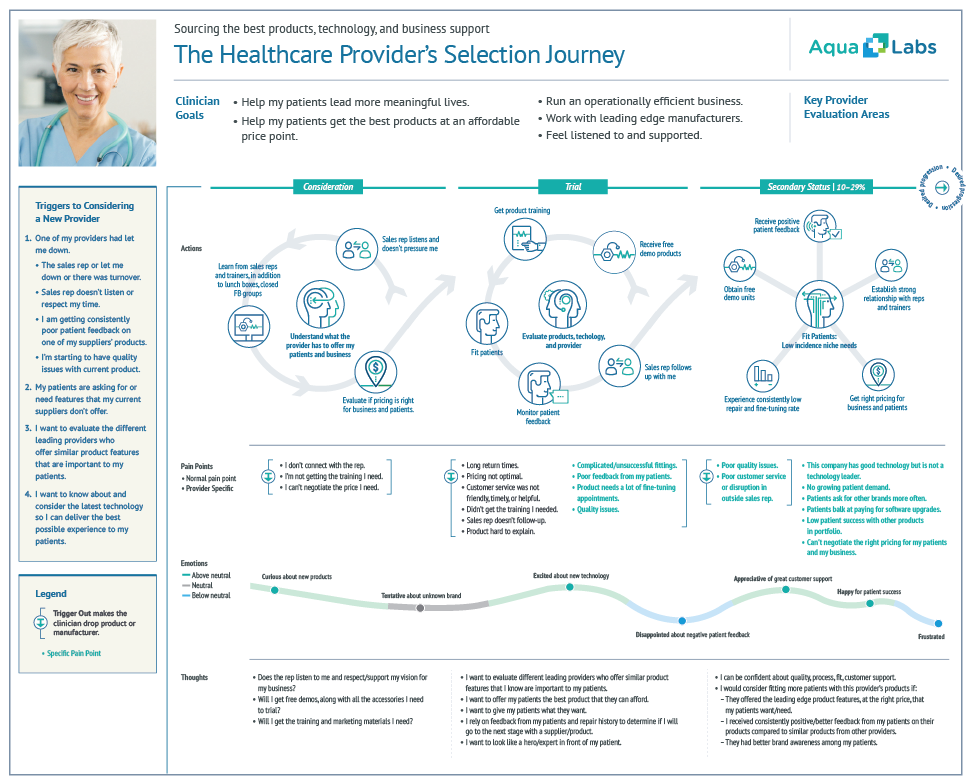
At Heart of the Customer, we’re known for creating world-class journey maps. (You could even say I’m driven by it, as you can see from my license plate!)
But sometimes, it’s not a journey that you need to map.
When a potential client contacts us to inquire about customer journey mapping, we first ask, “What are you looking to learn?” If the answer is “the customer journey,” we will be asking many more questions.
Understanding the Terminology
“What is the right journey?” is the second question in our Five-Question Framework. At the extremes, you would map either the end-to-end customer experience mapping or a specific sub-journey. Some CX folks refer to these as a customer experience map or a journey map, so I’ll use those terms for this post.
At the risk of oversimplifying, you need a customer experience map when you don’t know exactly where the problem is, and a journey map when you do, but need to go deeper.
In early 2019, CustomerThink CEO Bob Thompson put together an excellent piece of research that still talk about years later. (I originally wrote about it here.)
It honed in on what separates successful CX programs from the rest. The critical differentiator was that the best programs started with a customer experience map to understand the overall experience and biggest opportunities. They then created multiple journey maps to explore those findings in more depth.
So, what is a customer journey map?
A customer journey map is a detailed visualization of a customer’s interactions with a brand, product, or service. It charts the customer’s path from the first point of contact to the ultimate purchase, including any after-sales interactions.
It allows us to see our company’s processes from the customer’s perspective, helping us identify areas for improvement to enhance overall customer satisfaction.
What is a customer experience map?
A customer experience map goes a step further and goes beyond interactions with our business. It considers the customer’s broader experiences and emotions throughout their journey, accounting for feelings, motivations, and expectations at each step.
Customer Experience Maps go Wide
What is the purpose of a customer experience map?
The purpose of a customer experience map is multifold:
- Understanding customer perspective
- Identifying pain points and opportunities
- Unifying vision and strategy
- Designing better products/services
- Improving retention and loyalty
1. Understand Customer Perspective
An experience map helps us understand the customer’s perspective. It also helps us empathize with their needs and feelings by focusing on their emotions throughout their journey.
It goes beyond the ‘what’ and delves into the ‘why’ and ‘how’ of customer behavior.
2. Identify Pain Points and Opportunities
This tool identifies customer dissatisfaction areas and highlights opportunities to delight customers. It helps enhance our vision and strategy.
3. Unify Vision and Strategy
A customer experience map provides a holistic view of the customer journey. This can guide cross-departmental strategies.
It allows teams across the organization to understand their impact on the customer experience and align their goals.
4. Design Better Products or Services
By better understanding our customers’ emotions, expectations, and reasons for interacting with us, we can improve our products or services to meet their needs better. This results in higher customer satisfaction and loyalty.
5. Improve Retention and Loyalty
A positive customer experience often leads to repeat purchases and customer loyalty.
By mapping and improving the customer experience, we can increase customer retention and build long-lasting relationships that increase the lifetime value of a customer.
When to use experience maps
Experience maps work well when you need a broad understanding. Some use cases include:
- Inform new leadership (including a new CX leader) on the current state of the customer experience.
- Build a listening post strategy across the entire experience.
- Understand a specific customer segment, such as a generation or a new market.
- Diagnose challenges with customers of an acquired business.
About a third of our projects focus on an experience map. (Check out our book, How Hard Is It to Be Your Customer?, to see how “ABC Software” created an experience map to build their listening strategy for a segment of banks.)
In the “AquaLabs” sample map to the right (with anonymized text), a medical device company gained an understanding of a specific segment of healthcare practitioners (HCPs) who were only buying from them sporadically.
The company needed to learn how these HCPs worked with patients so that they could build programs appropriately.
Now look at the Meridian map pictured below. Notice how far more real estate is dedicated to what customers do than on the Meridian map?
Emotions are displayed in both, but they’re a relatively small part of the top map, unlike on Meridian’s, where they play a larger role. That difference goes back to AquaLabs’ goal: to understand what the HCPs do.
Customer Journey Maps go Deep

What is the purpose of a customer journey map?
Here are the key purposes of a customer journey map:
- Understanding customer interactions
- Identifying customer pain points
- Enhancing customer experience
- Unifying cross-functional teams
- Improving business performance
- Future planning and strategy
1. Understanding customer interactions
A customer journey map visually represents every interaction or touchpoint a customer has with a brand, product, or service.
This helps us understand the customer’s path and how they interact with our business.
2. Identifying customer pain points
By mapping the customer’s journey, we can identify points of friction or dissatisfaction in their interaction with our business.
These ‘pain points’ help us understand where we need to focus our improvements.
3. Enhancing customer experience
With a clear picture of our customers’ journey, we can better align our business processes and services to their needs.
This alignment leads to an improved overall customer experience.
4. Unifying cross-functional teams
Since the customer journey often spans different organizational departments, a customer journey map helps ensure all teams understand the customer’s path and role.
This unity promotes a customer-centric culture throughout the organization.
5. Improving business performance
By improving the customer’s journey, we enhance their satisfaction and loyalty, which in turn drives business growth.
The journey map provides actionable insights to increase conversion rates and foster customer loyalty.
6. Future planning and strategy
A customer journey map can also be used to plan for the future. It can be a valuable tool in:
- Predicting potential roadblocks
- Planning for product/service updates
- Strategizing marketing and sales initiatives
When to use customer journey maps
Journey maps work best to diagnose a specific portion of the overall experience. Some common examples:
- Customer attrition after a specific interaction.
- Poor survey scores for a portion of the journey.
- New business initiatives need to be informed by the voice of the customer (such as a new website or communications program).
For example, the map below is based on work Heart of the Customer did with a life insurance company. They had the initiative to change their underwriting and wanted to understand how their customers – in this case, financial professionals – felt about the existing journey.

Notice again that a fair amount of space was used to show what customers did. This isn’t true of most of our maps but again happens to be the case here.
Also, as there is little joy in underwriting, it only shows friction levels, as opposed to the Meridian map above, which reflects positive and negative emotions.
The Meridian map, featured in Jim Kalbach’s Mapping Experiences book and ours, is from a journey mapping initiative conducted for Meridian Health.
For that project, Meridian wanted to focus exclusively on the advanced radiology journey, from test scheduling to receiving results back from the doctor.
The steps of the journey were well-known, but Meridian needed to find out how customers felt about them.
Selecting the right scope for your mapping initiative is one of the top three requirements to drive change through journey mapping effectively.
There isn’t one choice that will be right for every situation. It comes down to fully understanding the current state of your experience…and the changes you need to drive to improve it.
Related Reading: The ADKAR Change Model and Customer Journey Maps
Customer Experience Map vs. Customer Journey Map Differences
The concept of a customer journey refers to a strategic approach encompassing all customer behaviors and engagements with a specific brand.
Customer Experience, often called CX, signifies how a business establishes and maintains connections with its customers throughout their journey – from the initial contemplation stage to becoming an advocate for the brand.
You can find out more in the following table.
| Customer Experience Map | Customer Journey Map | Which One to Choose | |
| Scope | Covers the entire customer experience | Focuses on specific parts of the experience | Depends on whether you want to view the entire customer experience or focus on specific touchpoints |
| Depth of Emotion | Deep insight into customer’s emotional state | May not always delve into emotional granularity | If a deeper understanding of customer emotions is required, choose an Experience Map |
| Customer Focus | Looks at a broader customer audience | More specific, it focuses on individual customer personas | If focusing on individual personas, choose a Journey Map. If considering a broader audience, choose an Experience Map |
| Purpose | Understand, improve, and innovate entire customer experience | Optimize specific customer interactions and touchpoints | If the aim is to innovate the entire experience, choose an Experience Map. If the goal is to optimize specific interactions, choose a Journey Map |
| Time Frame | Considers the entire duration of the customer lifecycle | Might focus on shorter durations or specific episodes | If the entire customer lifecycle is to be mapped, choose an Experience Map. If focusing on specific episodes, choose a Journey Map |
| Detail Level | More high-level, provides a broad view | More detailed, breaks down each interaction | If a high-level overview is required, choose an Experience Map. For a detailed, step-by-step view, choose a Journey Map |
| Business Application | Helps unify vision and strategy across entire organization | Useful for specific teams or departments | If unifying the entire organization’s strategy, choose an Experience Map. For specific team objectives, choose a Journey Map |
How are Customer Personas Used in Customer Experience and Journey Maps?
Customer personas are integral to the development of customer experience and journey maps. They provide detailed insight into your target audience, helping to shape and define the stages, touchpoints, and experiences along the customer journey. Here’s how they’re used:
- Understanding customer behavior
- Identifying touchpoints
- Highlighting pain points
- Personalizing experiences
- Predicting customer needs
- Guiding product development
1. Understanding customer behavior
Personas embody different customer segments’ needs, motivations, and behaviors. By incorporating them into experience and journey maps, businesses can better understand how different types of customers interact with their brand, product, or service.
2. Identifying touchpoints
Customer personas can help identify where customers interact with your business, whether through your website, a physical store, or social media platforms. By understanding these touchpoints, you can map out a more accurate and detailed customer journey.
3. Highlighting pain points
By understanding your personas’ goals, expectations, and potential barriers, you can use journey maps to identify and visualize their pain points. This can drive strategies for improving the overall customer experience.
4. Personalizing experiences
Understanding the preferences and needs of different personas allows businesses to tailor experiences and communications to resonate with them. This level of personalization can be outlined in your customer journey map.
5. Predicting customer needs
Journey maps, when created with customer personas, can help predict future customer needs. By understanding what drives your personas, you can forecast how their journey might evolve and proactively meet those needs.
6. Guiding product development
Personas can inform the direction of product development by providing insights into what features or services are most valuable to different customer segments. This can be integrated into experience maps to guide strategic planning.
Common Mistakes to Avoid when Creating Experience Maps and Journey Maps
Creating an Experience Map or Journey Map is not always a walk in the park. Throughout my career, I’ve seen numerous common pitfalls that can derail these essential tools for understanding and improving the customer journey.
Let me share some of the most frequent mistakes to avoid:
- Lack of clear goals
- Ignoring the customer’s perspective
- Relying solely on assumptions
- Creating overly complex maps
- Not updating maps regularly
- Not involving cross-functional teams
- Neglecting to use the map
Lack of clear goals
It’s easy to jump headfirst into creating an Experience Map without defining what you hope to achieve. Remember, these maps are tools designed to uncover specific insights about the customer journey. Ensure your goals are clear, achievable, and relevant to the task.
Here are some examples of goals related to experience and journey mapping:
| Goal | Description |
| Identify Pain Points | Uncover areas of user frustration or obstacles. |
| Enhance User Satisfaction | Ensure a seamless and positive user experience. |
| Increase Retention and Loyalty | Address pain points and optimize the journey for returning customers. |
| Streamline Processes | Eliminate redundancies or unnecessary steps. |
| Improve Onboarding Experience | Assist new users in navigating and understanding the product/service. |
| Optimize Conversion Points | Focus on stages where users most often convert. |
| Facilitate Cross-Departmental Collaboration | Foster understanding between departments. |
| Identify Up-selling Opportunities | Recognize areas receptive to additional offers. |
| Increase Accessibility | Make sure the journey is accessible to all, including those with disabilities. |
| Test and Iterate | Use the map to test design changes and ensure continuous improvement. |
Ignoring the customer’s perspective
In my early days, I made the mistake of creating journey maps based solely on my internal business perspective. It was only when I took the time to incorporate customer experiences, emotions and needs into the map that I truly began to see its value. Always build your map with a customer-centric view.
Relying solely on assumptions
It’s tempting to use internal assumptions to fill gaps in your map. However, relying solely on assumptions can lead to a skewed view of the customer journey. Always base your map on real data and insights from customer feedback where possible.
Overly complex maps
While creating detailed maps may seem beneficial, it’s easy to get lost in the weeds. Overly complex maps may discourage stakeholders from fully engaging with the insights. Strike a balance between detail and simplicity, ensuring the map communicates its key messages clearly.
Not updating maps regularly
The customer journey isn’t static; it constantly evolves as customer behaviors and expectations change. I’ve seen businesses create excellent maps, only for them to become obsolete because they weren’t updated regularly. Treat your maps as living documents, updating them as new data emerges.
Not involving cross-functional teams
Creating an Experience Map or Journey Map should not be done in isolation. I learned this the hard way when I created my first journey map without the input of key stakeholders. Now, I involve representatives from all relevant departments, as their insights can be invaluable in creating a more accurate map.
Neglecting to use the map
After investing time and resources into creating a comprehensive Experience Map or Journey Map, it can be easy to neglect the final step: using it to drive decision-making. Ensure you communicate the map’s insights to stakeholders and use it to inform your strategic decisions.
Final Thoughts
At Heart of the Customer, we are committed to accompanying you throughout this journey. Our dedication extends to assisting you in identifying and meeting your requirements, overcoming challenges, optimizing time management, streamlining processes, and, ultimately, enhancing both customer and employee experiences.
In today’s rapidly changing business environment, a robust employee experience strategy is not a luxury but a prerequisite for success. Not letting your strategy fall behind is crucial to ensure you stay ahead. Feel free to contact us at Heart of the Customer, and together, we can chart a distinctive employee journey that will propel your employee experience to unparalleled heights.
Get in touch today!




